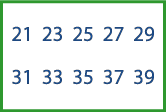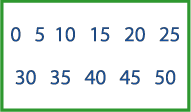Skip over navigation
Numbers can be sorted in many different ways. We are just going to be using the numbers from 0 to 50.
In this box there is a set of numbers:

In this box there is a different set of numbers:



Or search by topic
Number and algebra
Geometry and measure
Probability and statistics
Working mathematically
Advanced mathematics
For younger learners
Sorting Numbers
Age 5 to 7
Challenge Level 





- Problem
- Getting Started
- Student Solutions
- Teachers' Resources
Sorting Numbers
Numbers can be sorted in many different ways. We are just going to be using the numbers from 0 to 50.
In this box there is a set of numbers:

They are the odd numbers between 20 and 40.
In this box there is a different set of numbers:

They are multiples of five.
Now you can make your own sets. Think of a good title for each of your sets.
Why do this problem?
This problem provides an opportunity for children to sort and categorise, both of which are important mathematical processes. This open activity challenges children to find their own categories and then name them, which might mean it is a good way to introduce specific vocabulary.
Possible approach
You could begin by putting some numbers into a box on the board yourself and asking the children to describe the set. Encourage learners to find different ways of naming a particular group of numbers or introduce them to new vocabulary as appropriate. Pairs of children could come to the board to create their own set in a similar way.
Children could work in pairs, perhaps using digit cards/number cards, and pencil and paper. As they work, it is a great opportunity for you to listen to their justifications and how well they are able to use mathematical language.
As a plenary you could write several numbers on the board and ask pupils to say which one doesn't belong and why. Encourage creative responses to this - in fact any could be chosen if we give an appropriate reason.
Key questions
What is the same about these two numbers?
Can we find others that could go with them?
What could we call this set?
Is there another way we could describe the set?
Possible extension
Encourage learners to increase the range of numbers from which they are selecting examples.
Possible support
Some children might want to use just the numbers up to 20, for example, to start with. You could get them started by suggesting categories to make.
You may also like
Biscuit Decorations
Andrew decorated 20 biscuits to take to a party. He lined them up and put icing on every second biscuit and different decorations on other biscuits. How many biscuits weren't decorated?
Constant Counting
You can make a calculator count for you by any number you choose. You can count by ones to reach 24. You can count by twos to reach 24. What else can you count by to reach 24?

